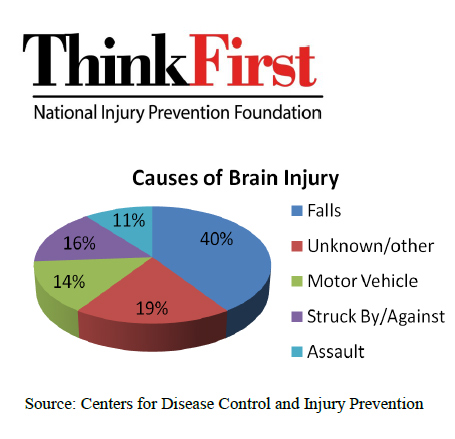Traumatic Brain Injury Fast Facts
Download the Fast Facts Document
 A traumatic brain injury, or TBI, is defined as an alteration in brain function, or other evidence of brain pathology, caused by an external force.1 An injury to the brain can be mild or severe, and can lead to life-long effects in cognition (thinking) and body functions, such as movement. Developing safe practices for driving, avoiding violence, protecting from falls and playing sports can help reduce the risk for brain injury.
A traumatic brain injury, or TBI, is defined as an alteration in brain function, or other evidence of brain pathology, caused by an external force.1 An injury to the brain can be mild or severe, and can lead to life-long effects in cognition (thinking) and body functions, such as movement. Developing safe practices for driving, avoiding violence, protecting from falls and playing sports can help reduce the risk for brain injury.
KNOW THE FACTS
- In 2010, 2.5 million emergency room visits, hospitalizations or deaths were associated with TBI.2
- TBI accounts for 30% of all injury related deaths in the U.S.2
- Most TBIs that occur each year are concussions or other forms of a mild TBI.2
- Approximately half of patients with a severe head injury will need surgery to remove or repair hematomas or contusions3
- The CDC estimates that there are 5.3 million Americans who have long term or life-long disabilities resulting from a TBI.4
HOW ARE TEENS AFFECTED?
- The risk of motor vehicle crashes is higher among 16-19 year olds than any other age group. In 2011, 2,650 teens 16-19 were killed and more than 292,000 were treated in emergency rooms for injuries suffered in motor-vehicle crashes.5
- Sports and recreational activities contribute to about 21% of all traumatic brain injuries to teens.6 Although sports-related injuries don’t often cause death, TBI’s are the leading cause of death in sports.6
- Violence is the third leading cause of death among people age 15-24.7
WHO ARE MOST LIKELY TO INCUR A TBI?
- Children 0-4 years, older adolescents 15-19 and adults 65 and older are the most likely to sustain a TBI.2
- Almost half a million emergency department visits each year for a TBI occur among children 0-14.2
- Adults 75 and older have the highest rates of TBI hospitalizations and deaths.2
Download the Fast Facts Document
[hr toptext=”” size=”medium” custom_size=”” hide_mobile_hr=”true”]
Sources
- Brain Injury Association of America. Cited 4 March 2015. http://www.biausa.org/about-brain-injury.htm
- Centers for Disease Control and Prevention. Injury Prevention & Control: Traumatic Brain Injury in the United States: Facts Sheet. 12 Jan, 2015. Cited 6 March, 2015. http://www.cdc.gov/traumaticbraininjury/get_the_facts.html#howbig
- National Institute of Neurological Disorders and Stroke. NINDS Traumatic Brain Injury Information Page. 3 Feb, 2015. Cited 6 Mar, 2015. http://www.ninds.nih.gov/disorders/tbi/tbi.html
- Brain Injury Statistics. Cited 6, March, 2015. http://www.brainandspinalcord.org/brain-injury/statistics.html.
- Centers for Disease Control and Prevention. Web-based Injury Statistics Query and Reporting System (WISQARS) [Online]. 2012. Cited 29 Sept 2014. http://www.cdc.gov/injury/wisqars
- American Association of Neurological Surgeons. Sports Related Head Injuries. Cited 6 July, 2015 http://www.aans.org/Patient%20Information/Conditions%20and%20Treatments/Sports-Related%20Head%20Injury.aspx
- Centers for Disease Control and Prevention. Injury Prevention & Control: Web-based Injury Statistics Query and Reporting System (WISQARS) [Online]. Cited 7 Dec 2014. http://www.cdc.gov/injury/wisqars
